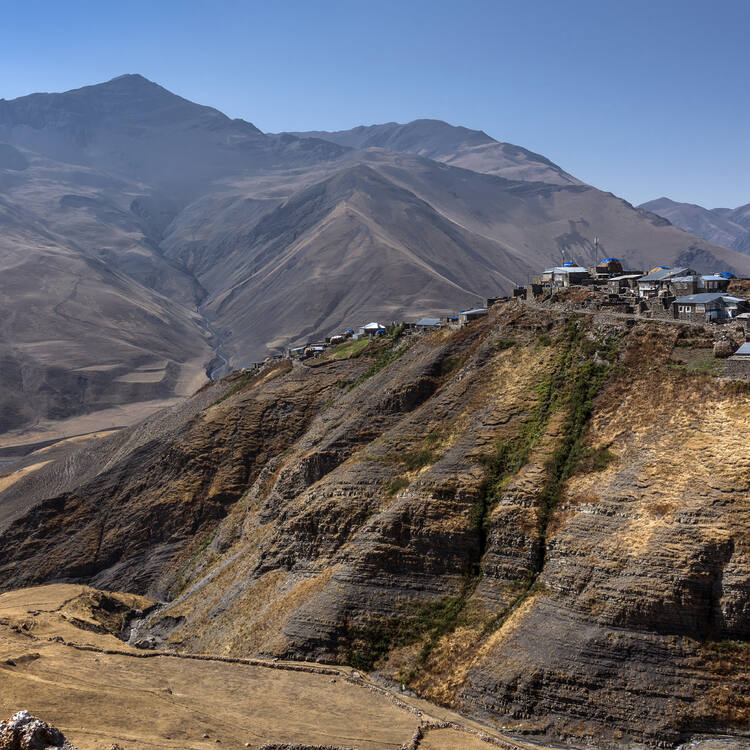Cultural Landscape of Khinalig People and “Köç Yolu” Transhumance Route
Cultural Landscape of Khinalig People and “Köç Yolu” Transhumance Route
Description is available under license CC-BY-SA IGO 3.0
Le paysage culturel du peuple Khinalig et la route de transhumance « Köç Yolu »
Description is available under license CC-BY-SA IGO 3.0
المشهد الثقافي لقرية خيناليق وطريق الانتجاع "كوتش يولو"
source: UNESCO/CPE
Description is available under license CC-BY-SA IGO 3.0
希纳利格人文化景观和移牧路线
source: UNESCO/CPE
Description is available under license CC-BY-SA IGO 3.0
Культурный ландшафт народа Хыналыг и маршрут перегона скота «Кёч-Йолу»
source: UNESCO/CPE
Description is available under license CC-BY-SA IGO 3.0
Paisaje cultural del pueblo khinalig y ruta de trashumancia “Köç Yolu”
source: UNESCO/CPE
Description is available under license CC-BY-SA IGO 3.0
Outstanding Universal Value
Brief synthesis
The Cultural Landscape of Khinalig People and “Köç Yolu” Transhumance Route is a continuing cultural landscape comprised of the high-mountain Khinalig village in northern Azerbaijan, high-altitude summer pastures and agricultural terraces in the Greater Caucasus Mountains, winter pastures in the lowland plains in central Azerbaijan, and the connecting 200-kilometre-long seasonal transhumance route called Köç Yolu (“Migration Route”). The village of Khinalig is home to the semi-nomadic Khinalig people, whose culture and lifestyle are defined by the seasonal vertical migration between summer (yaylaqs) and winter (qishlaqs) pastures, and who retain the ancient way of long-distance vertical transhumance. The organically evolved network of ancient routes, land-use features, temporary pastures and camping sites, irrigation systems, springs and wells, mausoleums, mosques, cemeteries, bridges, and infrastructure for animal husbandry illustrate a sustainable eco-social system adapted to extreme and diverse environmental conditions that has served to build and retain transhumance as the dominant economy.
Criterion (iii): The Cultural Landscape of Khinalig People and “Köç Yolu” Transhumance Route is an exceptional living testimony to the long-distance vertical transhumance cultural tradition of the Khinalig people, a tradition of communal transhumance in the Caucasus geo-cultural region. The property demonstrates a significant degree of preservation of its ancestral semi-nomadic eco-social system.
Criterion (v): The Cultural Landscape of Khinalig People and “Köç Yolu” Transhumance Route is an outstanding example of a long-standing traditional and sustainable land use that reflects the semi-nomadic Khinalig transhumance culture and lifestyle. Animal husbandry remains the dominant economy, though a highly vulnerable one. The range of physical features across a great diversity of landscapes illustrates an adaptation to extreme environmental conditions and the resilience of semi-nomadic socio-economic structures based on the sustainable use of natural resources.
Integrity
All the attributes necessary to convey the Outstanding Universal Value of the property are located within its boundaries. These attributes include the village of Khinalig, its surrounding landscape of summer pastures, agricultural terraces, and related infrastructure, and the network of ancient routes, traditional irrigation systems, places of worship, and archaeological sites. The attributes also include the architectural and infrastructural elements of the Köç Yolu route, the winter pastures and their infrastructure, and intangible attributes such as the collective planning, organisation, and implementation of transhumance practices, as manifested in architectural, infrastructural, and landscape elements, that are of vital importance for the practice of transhumance by the Khinalig people. The property is of adequate size to ensure the complete representation of the features and processes that convey its significance. It is highly vulnerable to the adverse effects of development and neglect.
Authenticity
The Cultural Landscape of Khinalig People and “Köç Yolu” Transhumance Route is authentic in terms of its forms and designs, materials and substance, uses and functions, locations and settings, traditions and management systems, and language and other forms of intangible heritage. While some changes have had an impact on the authenticity of the forms and designs, materials and substance, and uses and functions of some parts of the property, the key attributes are largely authentic and convey the Outstanding Universal Value of the property. The socio-spatial organisation of communal transhumance remains authentic despite a previous socio-economic reorganisation; traditions of semi-nomadic communal life remain effective, and the Council of Elders continues to act as an informal self-governing body in charge of collective affairs such as the seasonal migration, turns for grazing, and shared use of water and pastures.
Protection and management requirements
Most of the property is protected at the highest level under the Constitution of the Republic of Azerbaijan and its normative laws such as the Law on Culture, the Law on Preservation of Historical and Cultural Monuments, and the Law on the Veterinary Control (for animal herding). Presidential Decrees and Decisions by the Cabinet of Ministers also play a role in protecting the cultural and natural heritage. A protective designation for the entire property through a single protected Reserve is being achieved by means of a Presidential Order. In addition to the legal protection instruments, there are traditional mechanisms for protecting and safeguarding the tangible and intangible aspects of the property.
The property and its buffer zone are under the ownership of diverse public and private entities. The majority of the summer pastures, all the winter pastures, and the Köç Yolu transhumance route are owned by the State. The management system involves the Ministry of Culture, the State Tourism Agency and its subordinate Reserves Management Center, and the Khinalig Reserve. A new management entity for the property and its buffer zone will incorporate relevant sectoral government agencies, local governments, and local communities within a single participatory, cross-sectoral management framework. The management plan needs to be implemented. Its objectives and action plan are structured around the key aspects of the property, including the transhumance, land use, and intangible heritage. The existing informal communal management by the Council of Elders is planned to be integrated within the new management and coordination framework.
